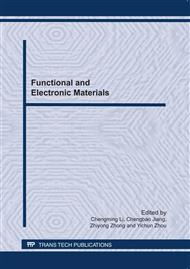p.396
p.402
p.407
p.411
p.416
p.422
p.427
p.433
p.439
The Dielectric Characteristics of Sr and Mg Doped CCTO Ceramics
Abstract:
Two kinds ceramics of pure CaCu3Ti4O12 (CCTO) and Sr/Mg doped (Ca0.25Cu0.75)0.5Sr0.5TiO3 + xMgO (x=0.01, 0.03, 0.05, 0.1, denoted as CCST-M-1, CCST-M-3, CCST-M-5, CCST-M-10, respectively) were prepared using the traditional solid phase reaction method. The dielectric properties were measured by HP 4194A Impedance/Gain-Phase Analyzer with the frequency range from 100 Hz to 1MHz. The temperature dependence of dielectric constant and loss tangent were measured for different frequencies. The variation relation of the critical temperature with the frequency was fitted theoretically which is in agreement with the Arrhenius law for pure CCTO. According to a variable power law to describe the paraelectric dielectric constant of ferroelectrics with diffuse phase transitions, the theoretical fitting was carried out for doped samples, and it was suggested that all doped samples exhibited the Debye-like relaxation. Among the doped and pure CCTO samples, CCST-M-1 was of the lowest dielectric loss at the whole measurement frequency, and whose I–V response curve was nonlinear suggesting a non-ohmic contact. The complex-impedance analysis results showed that the reduction in dielectric loss of CCST-M-1 sample can be attributed to the increase of grain boundary resistance. It is expect that these results are helpful to promote the CCTO-related materials to practical applications.
Info:
Periodical:
Pages:
416-421
Citation:
Online since:
June 2011
Authors:
Keywords:
Price:
Сopyright:
© 2011 Trans Tech Publications Ltd. All Rights Reserved
Share:
Citation:


